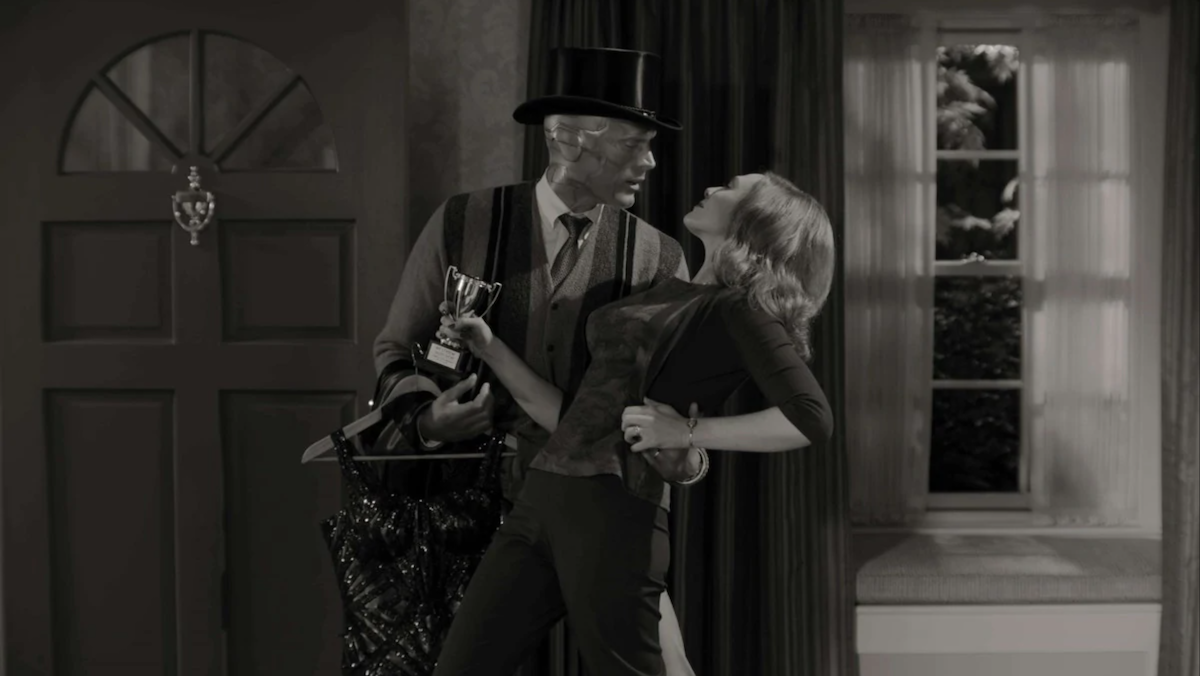WandaVision uses many classic sitcoms as a lens in which to follow and understand Wanda Maximoff’s life. But out of all the shows to which it draws inspiration, Bewitched seems like the most obvious homage. Just like Wanda, Bewitched‘s Samatha Stephens was a witch hiding in plain sight. She often uses magic secretively to fix bad situations and help out her husband Darrin.
But WandaVision‘s real connection to the classic ’60s show is how it explores and nuances trauma. The show never overtly copped to making points about matters of emotional unrest, like marriage issues and problematic gender norms. This kind of storytelling allowed Bewitched to explore heavier issues and their fallout in a humorous way.
In Bewitched, Samantha often used witchcraft to solve (but also create) problems in her life. Consider the season one episode “Help, Help, Don’t Save Me.” Darrin accuses Samantha of using witchcraft to mess with him and then calls her a liar when she denies it. Hurt by his accusations, Samatha uses magic to make herself invisible and sneaks out to her mother. Instead of talking things out with Darrin, Samantha walls herself off and disappears; her magic, in this case, is a crutch that helps her avoid her marriage issues and the deep hurt she feels from someone who should unconditionally believe in her.
WandaVision similarly shows Wanda using magic to solve everyday problems, like fixing a disastrous dinner or saving a talent show. But she’s also using magic to solve her own personal problems, to keep her happy reality intact. And in doing so, she’s creating problems for herself by refusing to acknowledge her denial and grief. Wanda has undergone great trauma, and yet you’d never know it because we’ve never had the chance to focus on the character the way WandaVision lets us. (To be fair, we’ve never had the chance to focus on any character’s trauma in such a nuanced way. Even the traumas of Tony, Steve, and Thor have been relegated to two-hour movies with other plotlines.)

Sony Pictures Television
A lot of what we’ve seen in WandaVision so far leads us to believe that Wanda and Vision are out of their depth when it comes to the series’ mysteries. But Wanda’s use of magic to specifically design her own narrative and ignore her own grief is a big tell; she may have more control over this reality than we’ve been led to believe. In the second episode, Wanda stands up after a conversation with Vision (Paul Bettany), only to discover she’s suddenly pregnant.
“Vision…is this really happening?” asks an emotional and delighted Wanda.
“Yes, my love. It’s really happening,” Vision replies.
Their moment of happiness is interrupted by the arrival of a strange man in a beekeeper uniform. This unsettles Wanda, who promptly utters the word “no” and consciously uses magic to rewind the story we’re watching, bringing us back to the happy moment. This time, their conversation ends as all sitcoms do: with a small and sweet kiss. But it also drives home the fact that Wanda is pulling herself into a deeper hole of denial the more she commits to this sitcom reality.

Disney
This specific moment feels like something that we might see in Bewitched. The conscious choice of the main character to fix a personal problem that’s bothering them, because they can. WandaVision takes this cues from a scene from another early Bewitched episode. In “Just One Happy Family,” Samantha’s witch parents Endora and Maurice reveal their true feelings about Samantha marrying a mortal. Disappointed and upset, Maurice “kills” Darrin by disintegrating him before an enraged Samantha forces him to bring him back. Just like Wanda reversing time so she doesn’t have to deal with a situation that could threaten her happiness, with the help of a little magic, the dinner party goes back to a normal instance of a new couple meeting their in-laws.
Bewitched never posited that magic solves all your problems, and often pointed out the opposite: quick fixes and nose wiggles don’t automatically make life easier. As powerful as Wanda is, her abilities aren’t a cure-all for the trauma she’s experienced, and it’s refreshing to see that explored in a more modern way. Using magic to mask years’ worth of trauma may not be healthy; but it’s almost a relief to see the character come to terms with emotions that have weighed on her for far too long.